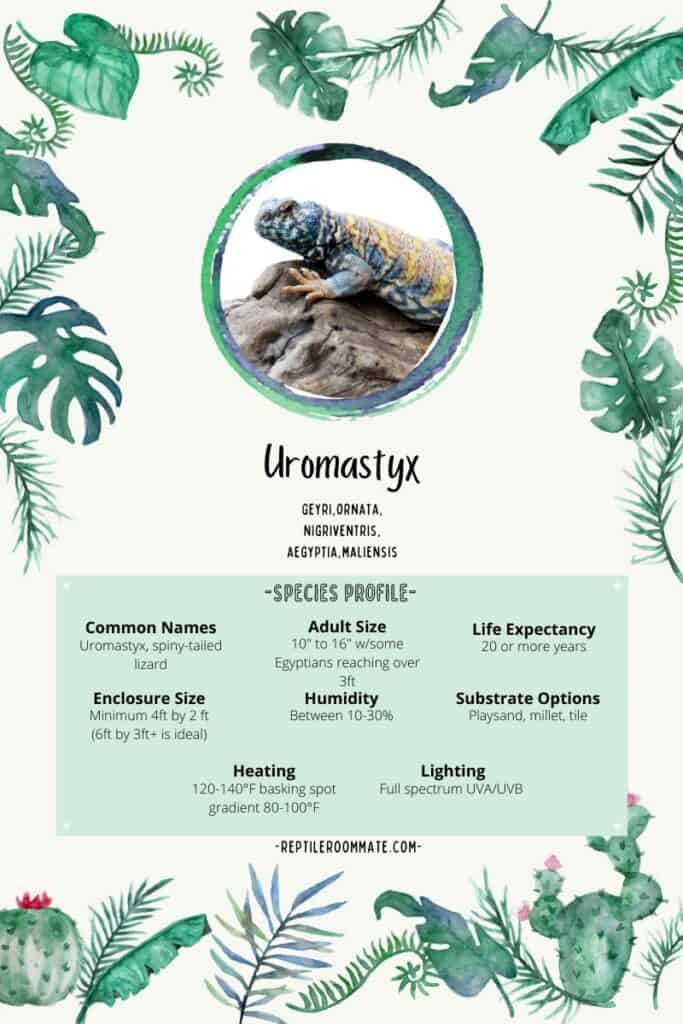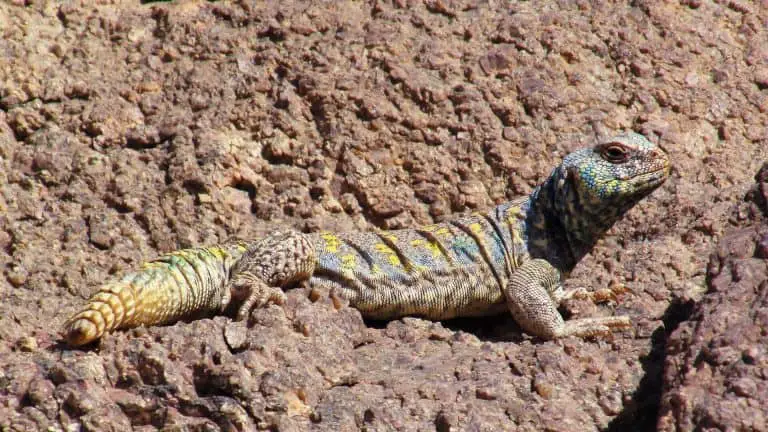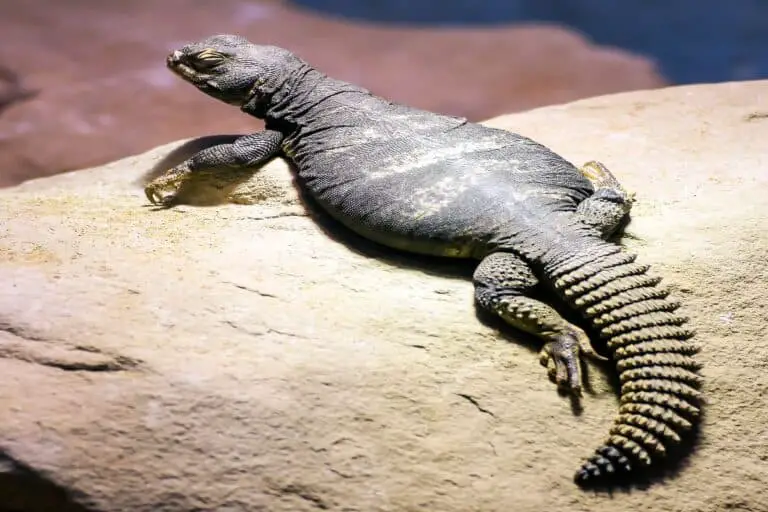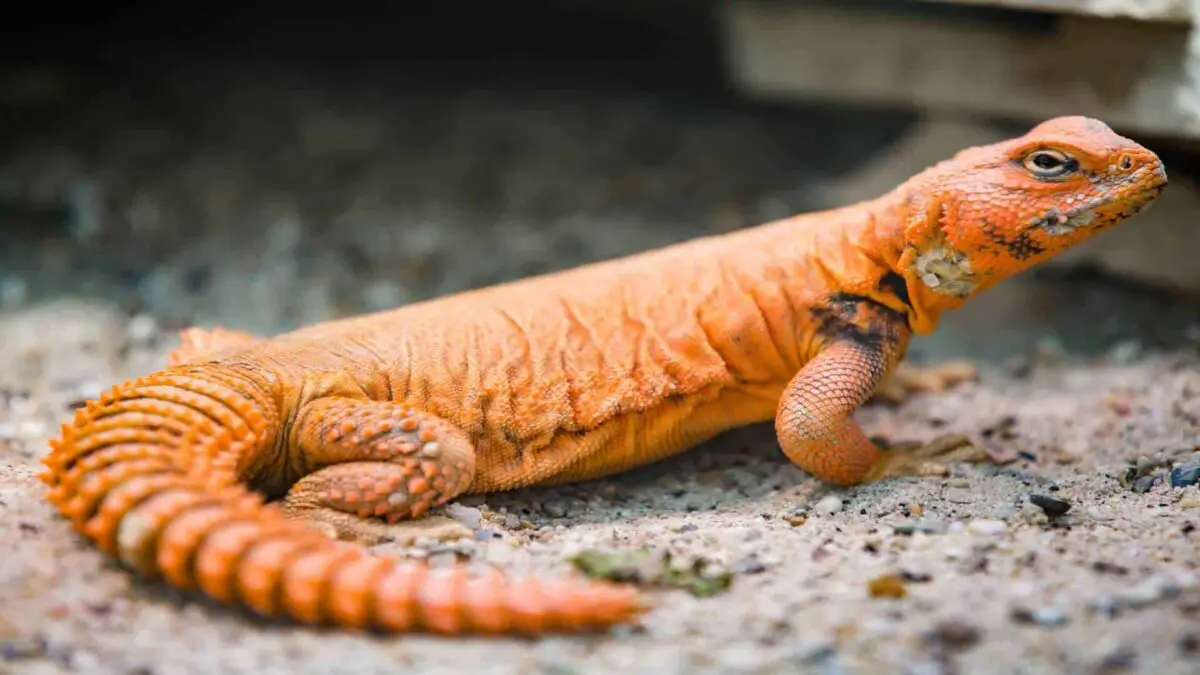Uromastyx Care Guide
One of the reasons I fell in love with reptiles is that they remind me of living, breathing dinosaurs! In my opinion one of the most dinosaur-like reptiles is the uromastyx!
I could definitely imagine a giant uromastyx with their blocky head and spiny tail roaming the earth so many millions of years ago!
The great thing is that we don’t have to rely on fossils and interpretations of what these “dinosaurs” look like, we can actually keep them in our homes!!
Uromastyx can make great pets for those fascinated by dinosaurs and for reptile keepers everywhere!
Reptile Roommate is a participant in the Amazon Services LLC Associates Program. As an Amazon Associate I earn from qualifying purchases.

Are Uromastyx Good Pets?
Uromastyx can be great pets! Uros are generally friendly and docile and are hardy reptiles. Uromastyx can even be great for beginners that are committed to providing them with all the necessary equipment they need to live happy, healthy lives!
Uromastyx are also vegetarians which works out great for those looking for a reptile that doesn’t eat rodents or that needs a constant supply of insects!
Many species of uromastyx are of a reasonable size and they can be found in some absolutely stunning colors!
Compared to other popular reptiles, I would say that uromastyx are not much more difficult or expensive than a comparably sized snake or chameleon with possibly an exception with one or two of their husbandry requirements…
Two requirements that uromastyx have that may be a bit more advanced or difficult than other reptiles is their lighting and heating needs.
Uromastyx need high amounts of light and what can seem like extreme temperatures! But, if you can provide both, a uromastyx could be just the pet for you!
The one downside (if you could call it a downside) to keeping a uromastyx might just be finding one.
You usually won’t find a uromastyx in your local pet store and will most likely have to get one from a reptile show, a breeder or online.
Tip: | Getting your uromastyx from a reptile show or breeder is actually much better than purchasing one from a big box store anyway!
Uromastyx Size and Weight
There are many species of uromastyx and they come in varying sizes.
There are smaller Uros that reach lengths between 10 and 14 Inches, medium sized species that grow between 16 and 19 inches and there is also the very large Egyptian uromastyx that can reach lengths of around 3 feet!
No matter what size lizard you’re looking for, from small to super-sized, you can find a uromastyx to meet your needs.
In comparison to other popular lizards such as bearded dragons and skinks (both approx. 12 – 24”), uromastyx match up well when it comes to these moderately sized lizards.
The Uromastyx’ Natural Habitat
Uromastyx are found throughout most of North and Northeast Africa as well as theMiddle East, even into Iran.
There are populations of uromastyx that can be found at elevations exceeding 3,000 ft.
They are desert dwelling lizards that live in extreme dry climates with daytime surface temperatures of over 120°F! During the day the uromastyx can be found basking in the extreme heat, otherwise it is found hiding in underground chambers or tight-fitting crevices and gaps between the rocky outcrops it calls home.
Species Overview
There are a number of popular uromastyx species that can be found in the reptile hobby. With a little research and digging, you should be able to find any of the species here:
Moroccan Uromastyx (Uromastyx acanthinurus nigriventris)
The Moroccan uromastyx or, “eyed” lizard because of the eye-like spots found along its back, is a ground dwelling lizard that lives in near desert-like scrublands in northern Africa.
Moroccans can reach 15 inches in length and weigh between 300 – 500 grams.
Adults attain impressive coloration, sporting shades of orange, red, yellow and gold with moderate amounts of black. They are truly impressive lizards!
Egyptian Uromastyx (Uromastyx aegyptia)
The Egyptian spiny tailed lizard is one of the most commonly available uromastyx.
Egyptian uromastyx are the giants of the uromastyx family, reaching lengths over 30 inches and weighing several pounds!
Their large size almost always necessitates a custom enclosure rather than an off-the-shelf option.
Mali Uromastyx (Uromastyx maliensis)
These spiny tailed lizards are found in hot, arid scrublands in Mali, Africa where surface temperatures can reach 120°F [48°C]!!
During winter the nighttime temps can drop to near 32 degrees, truly extreme conditions!
Male Mali uros are typically jet black with bright yellow markings, while females are a more drab brown or tan coloration.
Mali uros average between 12 and 14 inches with some males attaining lengths over 16 inches.
Saharan/Niger Uromastyx (Uromastyx geyri )
Saharan uromastyx are a smaller species of uro, averaging 11 to 14 inches, and are one of the more brightly colored spiny tailed lizards.
There are two phases of uromastyx geyri, the ‘red geyri’ and the ‘yellow geyri.’ The red phase is nearly a solid red (ish) to an almost neon orange color while the yellow phase almost shines like a neon sign!
Females of both phases are duller in coloration and have less patterning than the males.
Lifespan
Uroamstyx in captivity can live, on average, between 15 and 20 years. Some individuals have been known to live over 30 years! A pet uromastyx is a commitment for many years!

“Spined tale lizard (Uromastyx ornata)” by Valerio Allasia is licensed under CC BY-NC-ND 2.0
Do Uromastyx Like to Be Handled?
Uromastyx tend to be docile and good tempered although they can take some time to tame and develop trust.
It is far easier to tame a young uromastyx and develop trust than it is an adult that hasn’t been handled or socialized much at all.
Trust is developed slowly over time, it’s not something that happens overnight. Hand-feeding can be a great way to start to develop this bond. Short interactions a few times a day/week can start to build trust between you and your uromastyx.
Uromastyx tails are their means of defense, they use them to thrash and whip, and as such their tails are best left alone and not pet, stroked or held.
Handling your uromastyx for long periods of time outside of its enclosure can lead to your uromastyx becoming sluggish because of the very high temperatures that these lizards need.
Many keepers wrongly assume a sluggish uro is just a “calm or happy friend” when in reality it may be that they’re losing body temperature.
Do Uromastyx Bite? Do Uromastyx Bites Hurt?
Uromastyx have short, blunt teeth used more for tearing vegetation than for cutting (or aggression) and that’s a good thing…
When a uromastyx bites it’s kind of like a “little crocodile” and will often it’s best imitation of a ‘deathroll’ by latching on and then twisting and rolling it’s entire body!
Uromastyx also have powerful jaws with, thankfully, blunt teeth. A bite from a uromastyx can be quite painful and cause some surprising damage if they do their crocodile impression.
Thankfully, uromastyx are quite docile and are not prone to biting; even when very agitated they often choose to try to intimidate with an open mouth or slash and strike with their spiky tail!
Also to note is that a bite from a very large uro, like a nearly 3 foot Egyptian, will be considerably more painful and will have the potential to cause increased damage.
If you do get bit by your uromastyx it’s important to clean the area with warm, soapy water and apply a bandage to stop any bleeding.

Handling Your Uromastyx
Uromastyx being a heavier-bodied lizard, are heartier and more able to withstand handling than other more delicate lizards and geckos. .
Remember, handling any reptile is for the keepers enjoyment and pleasure and not the animal’s.
Like with many reptiles, initial contact should be slow and steady and trust should be developed over a period of time; gently handling your uro for a few minutes every day or so for a couple of weeks.
One great way to gain your uromastyx’ trust is to hand feed it.
Once your uromastyx realizes that you pose it no threat, they can be handled with ease and are a pleasure to hold.
Gentle handling and slow movements with your uro will help to earn, and to maintain, its trust.
Are Uromastyx Venomous?
While uromastyx may bear some slight resemblance to beaded lizards and gila monsters, they are not venomous.
Uromastyx Behavior
Uromastyx are a desert species of reptile that enjoy very hot temperatures and spend their days either basking in or hunkered down in burrows trying to get away from it.
Some popular reptiles are nocturnal, which can make them difficult to see or interact with since they are primarily awake and active during nighttime hours.
One benefit to uromastyx is that they are diurnal, they are active during daylight hours so they can be awake during the times that most keepers want to see them!
Uromastyx tend to be aggressive with others of their own kind and that goes doubly so for males.
You will notice some aggression from males towards the female during breeding in the forms of biting and tail thrashing
Are Uromastyx Smart? Can They Get to Recognize People?
I wouldn’t say that uromastyx are Einsteins of the reptile world, but that doesn’t make them dimwitted either.
By spending time with your uro, hand-feeding and developing trust, your uromastyx will definitely ‘learn’ who you are and remember you!
Your bond, that trust forms from your relationship is a testament to uro’s intelligence.
Uro Husbandry and Care
In some ways uromastyx are relatively easy to care for, especially compared to some other popular lizards or snakes. This face makes them acceptable reptiles for beginners.
Like all reptiles, uros need a source of heat, UVA/UVB lighting, a balanced diet and consistent clean up and maintenance to their habitats.
They will need an enclosure that can provide them with ample space and of a size that can generate a gradient of heat, from a hot basking spot to a cooler area, giving them the ability to regulate their body temperature.
Like other reptiles they will need a substrate for the bottom of their enclosure, hides and areas to find shelter and safety and specifically with uros, lots of fresh greens and vegetables.
…all pretty standard “reptile supplies.”
However, there are some details of uromastyx care that can be more complicated than your average reptile care.
Uromastyx heating and lighting needs can far outweigh what is necessary for many other popular reptile pets.
What Size Tank Does a Uromastyx Need?
Uromastyx are moderately active, medium to large sized lizards and they need large-sized enclosures.
Their enclosures need to be large not just for the size of the uro but also in order to create a proper temperature gradient throughout the habitat. Temperature regulation is imperative to keep uromastyx happy and healthy.
A uromastyx’ enclosure, whether it be an aquarium, reptile terrarium or custom made habitat needs to be able to withstand the extreme heat that uros need.
Smaller uros, those around 10 inches or so in length will need an enclosure measuring 36” x 18” x 24” in size. A 40 gallon breeder aquarium or equally sized terrarium can do well.
The average popular uromastyx species, ranging from 14 to 18 inches will require enclosures measuring 4ft by 2ft by 2ft.”
75 gallon aquariums are about 48”x18”x24” and you can find some ready built terrariums this size as well. A quality option is the ReptiZoo Large Terrarium found here.
Adult Egyptian uros will need custom 6ft enclosures!
Unfortunately, enclosure size may be another ‘strike’ for some beginner reptile enthusiasts or those unable to accommodate such a sizable habitat.
Again, size matters but if you can’t regulate your enclosure’s temperature and provide the needed heat gradient there isn’t a size good enough!
If you’re able to provide proper temperature and thermal gradients, bigger is always better when it comes to uromastyx enclosure size! (horizontal area also takes precedence to vertical space in an uro’s habitat as they aren’t very big climbers.
Tip: | Large enclosures (bigger footprint) will most likely need even more heat lamps and lighting!
Lighting Requirements for Keeping Uromastyx
Uromastyx need for both UVA and UVB light along with their need for an intensely heated basking spot, go hand in hand.
UVA light helps stimulate appetite and encourages natural behavior while UVB light is needed to absorb calcium from their diet and for good bone growth.
All UVB bulbs produce both UVB and UVA light, however not all UVA bulbs will provide UVB.
You can use fluorescent light fixtures specifically designed for reptiles, like this one from Reptisun…
…or you can use mercury vapor bulbs in your own fixture with a minimum 8-10% UVB output, like this one from Exo Terra.
Uros should receive between 10 and 12 hours of lighting per day; your light source should be placed 10 to 12” from the basking spot to create a basking surface temperature of about 120-140°F!
Maintaining an adequate daytime temperature for your uromastyx is essential.
As mentioned previously, the basking spot should be between 120 and 140°F and a uro’s enclosure should have an ambient temperature of around 100°F at the warm end and a temperature of 80°F at the cooler end.
Desert-like temperatures indeed!
Your basking bulb may provide an adequate basking spot temperature but may not be able to keep the ambient enclosure temperature up to required levels.
The use of ceramic heat emitters may be required to keep ambient temperatures at the necessary levels.
Temperature will need to be accurately measured and one of the best ways to accomplish this is when a temp gun, essential for checking basking spot temperatures, and a digital thermometer.
You’ll need multiple temperature probes with your digital thermometer as both the warm end and cool side need to have probes placed near substrate level.
Overnight temperatures in an uromastyx enclosure should drop considerably compared to daytime temps, a range between 75° and 78°F is ideal.
Uromastyx have little indeed for humid environments. Being a desert dwelling species of lizard, uros are well equipped to handle the harsh dry environment. (in fact too much humidity can cause respiratory infections)
An ideal humidity level in a uromastyx enclosure is somewhere between 10% and 30%.
Uromastyx in the wild do take shelter in slightly more humid burrows which we can replicate in captivity by providing a hide, or shelter with slightly damp sand and peat moss.
This hide should not have more than 40-45% humidity.
Substrate for Your Uromastyx Habitat
In nature uromastyx like to burrow and dig in the substrate to hide from predators and also to get away from the oppressive heat.
This can be somewhat difficult to replicate in captivity but there are a few substrate products that allow uros to burrow and will hold its shape, creating tunnels and hides. Zoo Med’s Excavator Clay Burrowing Substrate is a quality example.
Such substrates however, require deep layers that may not be practical for your enclosure. Many uromastyx keepers use inexpensive play sand as their preferred substrate.
You can also go the very simple route of newspaper, paper towel, slate tile or even white millet bird seed! (which acts as a substrate and a nutritious snack)
Can You Keep More Than One Uromastyx Together?
Male uromastyx should NEVER be kept together, they are territorial and very aggressive with one another and will fight constantly.
Male and female pairs are also a bad idea because the male will constantly try to breed with the female, harassing her almost to death.
Females could be kept together however, the space and large size that a single uromastyx needs can be a challenge to provide; adding another uro to the mix really creates problems with the necessary habitat size.
Many, many reptiles do not need nor do they desire ‘friends’ or company when it comes to husbandry and their enclosures.
You will have a healthier and happier reptile (most of the time) when kept as a single specimen; this also applies to uromastyx.
What Do Uromastyx Eat?
One of the big positives of keeping uromastyx for many people is uro’s almost completely vegetarian diets.
Many people are put off or shy away from reptiles because of the need to feed rodents or live insects.
With uromastyx you don’t have such worries about mice and rats or creepy, crawly bugs!
Another great thing about your uromastyx’ diet is that you don’t need to go to the pet store or order from specialty online shops; most of what they eat can be purchased at your local grocery store! (or even farmer’s market)
A uro’s diet will consist of various green plant matter. Collard, turnip and mustard greens as well as escarole, endive, radicchio and bok choy.
Most dark green leafy plants and vegetables are great staples of a uro’s diet. Prickly pear cactus, sold in many ethnic or specialty markets, are a welcome treat!
Greens like kale, spinach, broccoli and cabbage should be limited because of the way they can integer with calcium absorption.
Your uromastyx’ ‘salads” should be chopped up and presented in a bowl close to their basking spot.
Uros also enjoy seeds, lentils, millet and small beans as well as some vegetables.
Uromastyx Dietary Staples:
- Greens (collard, mustard, turnip)
- Lettuce (endive, radicchio, chicory)
- Bok choy
- Arugula
- Watercress
Uromastyx Dietary Supplements:
- Pumpkin
- Squash
- Green beans
- Peas
- Bell peppers
- Prickly pear cactus
- Cucumber
- Parsnips
- Zucchini
- Lentils
- Millet
- Flax seeds
- Flowers (hibiscus dandelion, squash blooms, rose petals)
Can My Uromastyx Eat Insects?
Uromastyx can be very fond of insect treats, however any insects you feed your uromastyx should be fed very infrequently; if at all.
Insects such as crickets, mealworms or superworms can be given sparingly.
Uromastyx can be fed greens daily and their diets can be supplemented with fresh vegetables once or twice a week. The aforementioned nuts and seeds can also be added to their diets a few times a week.
Uromastyx need to have calcium in their diets and many keepers dust their uro’s meal once a week with a high quality reptile calcium supplement. We really like Zoo Med’s Repti Calcium combined with Rep-Cal Herptivite Multivitamins.
Do Uromastyx Need Water? Where Do They Get Their Water From?
Believe it or not, most uromastyx will show no interest in drinking water! Uros get all of their water needs from the greens that they consume.
Occasionally you can spray a bit of water (light misting) on their greens when serving them a meal.
Because uromastyx conserve water so well, you will often see them excrete mineral salts from a special gland near their nose; a whitish crust deposits can sometimes form and should not be cause for alarm.
Some keepers still feel the need to provide a bowl of water in their uro’s enclosure, but this can actually do more harm than good.
With the very high temperatures needed in their habitat, a uro’s enclosure can become too humid because of the evaporation from a water dish.
It is best to feed your uromastyx fresh leafy green and vegetable matter to meet their water requirements.
How Long Can a Uromastyx Go Without Eating?
Uromastyx during their ‘winter cooldown’ period, can go days to weeks without eating.
This is a different scenario however than their normal behavior throughout the rest of the year.
Brumation; Winter Cooling Period
During the uromastyx’ life cycle there are seasonal changes that affect uromastyx activity.
It is a natural process that during the winter season, uros will start to “slow down” and become less active, preparing for the ‘difficult’ winter.
As winter approaches and ambient temperature stops to drop, you may notice your uromastyx becoming less active, hiding more and eating and defecating less, basically a ‘sleepy’ little dinosaur. This can understandably concern new uromastyx keepers.
Some may reason, “why not just adjust your heat lamps and lighting to compensate for the dropping temperatures outside?”
This can be done, however many times it will not stop the uromastyx’ actions to begin its cooling period. It’s hard to ‘fool’ nature!
It’s best to start to slowly decrease your uro’s photoperiod and let temperatures fall naturally a bit as late Autumn begins.
Starting near the end of winter you’ll gradually increase your uro’s photoperiod and allow temps to slowly climb back up until you reach ‘normal’ levels beginning in spring.
During winter cooling, you’ll want to provide small meals every three to four days, which many times won’t even be eaten. This is okay!
You may not see your lizard for days or weeks at a time as they prefer to spend more and more time in their hides.
There is an excellent video, from a uromastyx breeder, here talking and teaching all about uromastyx winter cooldown and the “how’s and why’s.”
Why Does My Uromastyx Have a Poor Appetite? (NOT During Cooldown)
Uromastyx will greatly reduce their consumption of food during winter cooldown, however poor appetite in uros at other times of the year can be symptoms of other issues.
7 Reasons Why Your Uro Is Not Eating
A new home -your uromastyx will need some time to acclimatize to its new surroundings and enclosure
Stress -stress has a large impact on many animals. Ensure that your uro’s husbandry requirements are benign met
Infection/illness -infection and/or illness can have an impact on uromastyx appetite
Parasites -like infections, parasites can cause your uromastyx to stop eating
Insufficient heat/low temperatures -temperatures too low will cause your uromastyx to become sluggish, not eat, and fail to thrive
Insufficient lighting -lighting is very important to your uromastyx and helps stimulate appetite
Shedding – many reptiles, including uromastyx will refuse to eat just before beginning the shedding process
Can Uromastyx Lose Their Tail?
Uromastyx, unlike various geckos and other lizards, cannot lose their tails; otherwise known as caudal autonomy.
Some reptiles self-amputate (caudal autotomize) their tails when threatened or while trying to escape danger.
Uromastyx however, use their spiky tails as defensive weapons, whipping and slashing them to ward off any potential predator or threat.
Tail Rot and Other Common Health Issues
Most common uromastyx health problems can be prevented with proper husbandry and diet, however issues can and do arise.
Excess humidity can cause respiratory infections and scale rot, while poor substrates such as orchid bark, calcium sand and walnut shells can cause problems with impaction when ingested.
Tail rot is a bacterial or fungal infection resulting from excess moisture or humidity in a uromastyx’ enclosure.
A uro’s tail can eventually turn black and fall off from bad cases of tail rot, a veterinarian visit is advised.
Not providing a nutritious and balanced diet can cause vitamin and mineral deficiencies such as the dreaded MBD -metabolic bone disease.
Metabolic bone disease is common in reptiles that do not receive proper calcium, either through their food or supplemented, in their diets.
Signs of MBD include disfigured bone growth, swollen joints, soft mouth and jaws along will shaking or trembling and general illness
High Protein Diets Are Problematic for Uromastyx
Excess protein in an uromastyx’ diet can overwork the kidneys and liver and ultimately impair function in these organs.
Such issues should be brought to the attention of an experienced veterinarian. Check out our veterinarian resource page to find a veterinarian in your area.
How Much Does a Uromastyx Cost?
Uromastyx, depending on species, can be had for just under $100 to upwards of $300-$500.
Some Uros can even be over $1,000 depending on coloration and morph! Price will ultimately depend on the specific species you are looking for.
Some general prices for popular species are as follows;
- Ornate (ornatus) uromastyx @$350-$500
- Egyptian (aegypticus) uromastyx @$350
- Moroccan (acanthinura) uromastyx @$150-$200
- Mali (maliensis) uromastyx @$150
- Saharan / Niger (geyri) uromastyx @ $80-$150
Some trusted uromastyx breeders can be found here:
Comprehensive Uromastyx Guide; Just the Beginning…
Uromastyx are incredible reptiles! As I mentioned in the introduction, I think they are “mini dinosaurs” that we can take care of, interact with and observe right in our own homes!!
Learning about and perhaps getting a uromastyx of your own is just the first step into the wonderful world of reptiles! (dinosaurs!)
“Dornschwanzagame (Uromastyx geyri) Blumengärten Hirschstetten” by Manfred Werner is licensed under CC BY-SA 3.0


